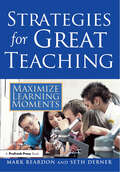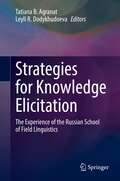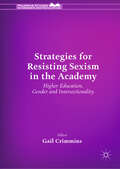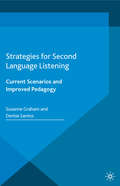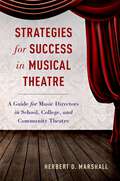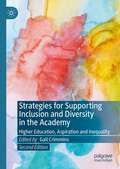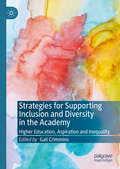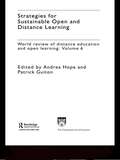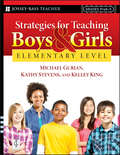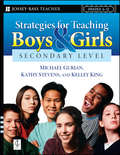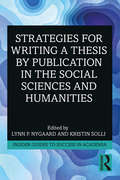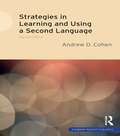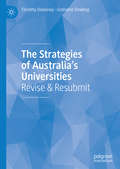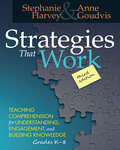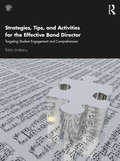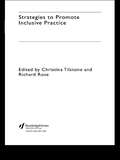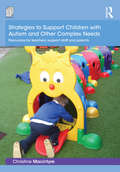- Table View
- List View
Strategies for Great Teaching: Maximize Learning Moments
by Mark Reardon Seth DernerThis exciting, practical guide offers teachers easy-to-implement strategies that help students draw personal meaning from the curriculum. Filled with great tips for engaging learners, this book is a must for any teacher. The authors show how a variety of strategies—cooperative learning, direct instruction, inquiry, reflective writing, and experimentation—can be used to help learners bond with the content.Consider this a teacher-friendly guidebook for creating moments of genuine student understanding and comprehension. For example, this book offers lessons in which students:play the part of television reporters, interviewing other students about content they have learned;create visually complex pictures and graphs to represent information or concepts;use mathematical symbols to capture their understanding of relationship and events inherent in the content; andplay a classroom version of the old television game show The $10,000 Pyramid to identify patterns and seek meaning.Each strategy explored in this book provides a unique type of “e-moment” (engaging moment) that connects with students through their learning preferences and styles. Across the curriculum, teachers will learn how to better engage students and increase comprehension by adapting these strategies to their own specific needs.Educational Resource
Strategies for Great Teaching: Maximize Learning Moments
by Mark Reardon Seth DernerThis exciting, practical guide offers teachers easy-to-implement strategies that help students draw personal meaning from the curriculum. Filled with great tips for engaging learners, this book is a must for any teacher. The authors show how a variety of strategies—cooperative learning, direct instruction, inquiry, reflective writing, and experimentation—can be used to help learners bond with the content.Consider this a teacher-friendly guidebook for creating moments of genuine student understanding and comprehension. For example, this book offers lessons in which students:play the part of television reporters, interviewing other students about content they have learned;create visually complex pictures and graphs to represent information or concepts;use mathematical symbols to capture their understanding of relationship and events inherent in the content; andplay a classroom version of the old television game show The $10,000 Pyramid to identify patterns and seek meaning.Each strategy explored in this book provides a unique type of “e-moment” (engaging moment) that connects with students through their learning preferences and styles. Across the curriculum, teachers will learn how to better engage students and increase comprehension by adapting these strategies to their own specific needs.Educational Resource
Strategies for Knowledge Elicitation: The Experience of the Russian School of Field Linguistics
by Tatiana B. Agranat Leyli R. DodykhudoevaThis volume provides an overview of experimental methods, approaches, and techniques used by field linguists of the Russian school, and highlights the fieldwork experience of Russian scholars working in regions with a range of languages that differ genetically, typologically, and in the degree of their preservation.The collection presents language and sociolinguistic data relating to fieldwork in diverse languages: Uralic, Altaic, Paleo-Siberian, Yeniseian, Indo-European Iranian, Vietic, Kra-Day, and Mayan languages, as well as pidgin.The authors highlight the fieldwork techniques they use, and the principles underlying them.The volume’s multidisciplinary approach covers linguistic, ethnolinguistic, sociolinguistic, educational, and ethnocultural issues. The authors explore problems associated with the study of minority languages and indicate diverse and creative techniques for data elicitation. Close collaboration with speakers lies at the core of their approach. The collection presents strategies for eliciting systems of knowledge from mother-tongue speakers, triggering linguistic self-awareness, and providing semantic and morphosyntactic context for their languages.This publication is intended for academics, and for specialists in the field of linguistics and minority and indigenous languages. It will also benefit students as a guide to field research, as well as language activists, interested in documenting and preserving their mother tongue.
Strategies for Resisting Sexism in the Academy: Higher Education, Gender and Intersectionality (Palgrave Studies in Gender and Education)
by Gail CrimminsThis book harnesses the expertise of women academics who have constructed innovative approaches to challenging existing sexual disadvantage in the academy. Countering the prevailing postfeminist discourse, the contributors to this volume argue that sexism needs to be named in order to be challenged and resisted. Exploring a complex, intersectional and diverse arrangement of resistance strategies, the contributors outline useful tools to resist, subvert and identify sexist policy and practice that can be deployed by organisations and collectives as well as individuals. The volume analyses pedagogical, curriculum and research approaches as well as case studies which expose, satirise and subvert sexism in the academy: instead, embodied and slow scholarship as political tools of resistance are introduced. A call for action against the propagation of sexism and gender disadvantage in the academy, this important book will appeal to students and scholars of sexism in higher education as well as all those committed to working towards gender e/quality.
Strategies for Second Language Listening: Current Scenarios and Improved Pedagogy
by Suzanne Graham Denise SantosThis book seeks to help teachers teach listening in a more principled way by presenting what is known from research, exploring teachers' beliefs and practices, examining textbook materials, and offering practical activities for improving second language listening.
Strategies for Success in Musical Theatre: A Guide for Music Directors in School, College, and Community Theatre
by Herbert D. MarshallIn Strategies for Success in Musical Theatre, veteran musical director and teacher Herbert Marshall provides an essential how-to guide for teachers or community members who find themselves in charge of music directing a show. Stepping off the podium, Marshall offers practical and often humorous real-world advice on managing auditions; organizing rehearsals; working with a choir, choreographer, and leads; how to run a sitzprobe, a technical rehearsal, and a dress rehearsal; how to manage the cast and crew energy for a successful opening night; and ways to end the experience on a high note for all involved. Throughout the book, Marshall emphasizes the importance of learning through performance and the beauty of a group united in a common goal. In doing so, he turns what can appear as a never-ending list of tasks and demand for specialized knowledge into a manageable, educational, and ultimately engaging and fun experience for all. Because the techniques in Marshall's book have been thoroughly workshopped and classroom tested, they are based in proven pedagogy and will be of particular use for the music director in acting as a teaching director: someone imparting theatrical knowledge to his or her cast and production staff. Marshall provides both extended and abbreviated timelines, flexible to fit any director's needs. Marshall's book is a greatly beneficial resource for music education students and teachers alike, giving an insightful glimpse into the range of possibilities within a music educator's career. Musicians and actors with varying levels of skill and experience will be able to grow simultaneously through Marshall's innovative teaching plans. Through collaborative techniques, steps in the book serve to educate both director and student. Thoroughly illustrated with charts, diagrams, and scores, Strategies for Success in Musical Theatre is an ideal companion for all who work with school and community based musical theater productions.
Strategies for Supporting Inclusion and Diversity in the Academy: Higher Education, Aspiration and Inequality
by Gail CrimminsThis book explores tried and tested strategies that support student and faculty engagement and inclusion in the academy. These strategies are anchored by a brief exploration of the history and effect/s of exclusion and deprivilege in higher education. However, while many publications exploring academic inequality focus on the causes and impacts of structural, psychological and cultural exclusion based on racism, sexism, classism and ableism, they rarely engage in interventions to expose and combat such de/privilege. Capturing examples of inclusive practices that are as diverse as student and faculty populations, these strategies can be easily translated and employed by organisations, collectives and individuals to recognise and combat social and academic exclusion within higher education environments.
Strategies for Supporting Inclusion and Diversity in the Academy: Higher Education, Aspiration and Inequality
by Gail CrimminsThis book explores tried and tested strategies that support student and faculty engagement and inclusion in the academy. These strategies are anchored by a brief exploration of the history and effect/s of exclusion and deprivilege in higher education. However, while many publications exploring academic inequality focus on the causes and impacts of structural, psychological and cultural exclusion based on racism, sexism, classism and ableism, they rarely engage in interventions to expose and combat such de/privilege. Capturing examples of inclusive practices that are as diverse as student and faculty populations, these strategies can be easily translated and employed by organisations, collectives and individuals to recognise and combat social and academic exclusion within higher education environments.
Strategies for Sustainable Open and Distance Learning: World Review of Distance Education and Open Learning: Volume 6
by Andrea Hope Patrick GuitonAdaptability and the ability to handle rapid and ongoing change are essential for successfully managing any modern educational enterprise, and open and distance learning is no exception. In an often over-looked field, this volume examines the nature of sustainability in open and distance learning using case material from a wide range of current educational contexts worldwide. The books themes include: reflection and analysis of the management of change collaboration staff development quality assurance and funding in an increasingly globalized environment. This book also reassesses the core processes involved in course development, delivery, and student support, in a world that is both linked and divided by access to the latest technologies. In a rapidly changing world, this book shows how the path from policy to sustainable practice is rarely easy. However, through consistent attention and commitment to meeting the needs of learners, sustainability can be achieved.
Strategies for Sustainable Open and Distance Learning: World Review of Distance Education and Open Learning: Volume 6
by Andrea Hope Patrick GuitonAdaptability and the ability to handle rapid and ongoing change are essential for successfully managing any modern educational enterprise, and open and distance learning is no exception. In an often over-looked field, this volume examines the nature of sustainability in open and distance learning using case material from a wide range of current educational contexts worldwide. The books themes include: reflection and analysis of the management of change collaboration staff development quality assurance and funding in an increasingly globalized environment. This book also reassesses the core processes involved in course development, delivery, and student support, in a world that is both linked and divided by access to the latest technologies. In a rapidly changing world, this book shows how the path from policy to sustainable practice is rarely easy. However, through consistent attention and commitment to meeting the needs of learners, sustainability can be achieved.
Strategies for Teaching Boys and Girls -- Elementary Level: A Workbook for Educators
by Michael Gurian Kathy Stevens Kelley KingIn his best-selling classic Boys and Girls Learn Differently, Michael Gurian explained the origin and nature of gender differences in the classroom. His important book explored the behavior teachers observed and the challenges they faced with both boys and girls in their classrooms. Taking the next step, Strategies for Teaching Boys?Elementary Level: A Workbook for Educators and Girls offers teachers a hands-on resource that draws on the Gurian Institute's research and training with elementary schools and school districts. The workbook presents practical strategies, lessons, and activities that have been field-tested in real classrooms and developed to harness boys' and girls' unique strengths. The workbook is designed to help teachers build a solid foundation of learning and study habits that their students can use in the classroom and at home. It covers the key curricular areas and offers proven techniques to make learning, no matter what the subject, more engaging for all students. The workbook is an essential resource for all teachers who want to improve their practice and get the most from all students?whatever their gender.
Strategies for Teaching Boys and Girls -- Secondary Level: A Workbook for Educators
by Michael Gurian Kathy Stevens Kelley KingIn his best-selling classic Boys and Girls Learn Differently, Michael Gurian explained the origin and nature of gender differences in the classroom. His important book explored the behavior teachers observed and the challenges they faced with both boys and girls in their classrooms. Taking the next step, Strategies for Teaching Boys and Girls?Secondary level: A Workbook for Educators offers teachers a hands-on resource that draws on the Gurian Institute's research and training with secondary schools and school districts. The workbook presents practical strategies, lessons, and activities that have been field-tested in real classrooms and developed to harness boys' and girls' unique strengths. The workbook is designed to help teachers build a solid foundation of learning and study habits that their students can use in the classroom and at home. It covers the key curricular areas and offers proven techniques to make learning, no matter what the subject, more engaging for all students. The workbook is an essential resource for all teachers who want to improve their practice and get the most from all students?whatever their gender.
Strategies for Writing a Thesis by Publication in the Social Sciences and Humanities (Insider Guides to Success in Academia)
by Lynn P. Nygaard Kristin SolliResponding to the growing popularity of the thesis by publication within doctoral education, this book offers practical advice and critical discussion of some of the central choices and challenges that PhD students considering dissertation options face. Drawing on current research and informed by extensive experience of working with and running workshops for PhD candidates who write article-based dissertations, this book gives readers an idea of what writing a thesis by publication entails – what its purpose is, what the various expectations might be for this emerging genre, and what the challenges might be in writing one. Particular emphasis is put on how to put the individual articles together to create a coherent thesis that clarifies the student’s individual original contribution. Written primarily for students, Strategies for Writing a Thesis by Publication in the Social Sciences and Humanities covers key topics such as: how the genre has developed, with an emphasis on the role of the narrative (introductory text) that accompanies the articles typical rhetorical challenges that writers of such dissertations face strategies for handling the writing process specific challenges of demonstrating doctorateness in the thesis by publication and strategies for addressing them institutional variations that the thesis writer should seek clarification on as early as possible structural elements of the narrative and their main functions the range of choices that can be made throughout the doctoral journey and thesis writing. This book is a must-read for PhD candidates and supervisors new to the genre, as well as those involved in directing PhD programmes who are interested in the pedagogical implications of the move towards article-based dissertations.
Strategies for Writing a Thesis by Publication in the Social Sciences and Humanities (Insider Guides to Success in Academia)
by Lynn P. Nygaard Kristin SolliResponding to the growing popularity of the thesis by publication within doctoral education, this book offers practical advice and critical discussion of some of the central choices and challenges that PhD students considering dissertation options face. Drawing on current research and informed by extensive experience of working with and running workshops for PhD candidates who write article-based dissertations, this book gives readers an idea of what writing a thesis by publication entails – what its purpose is, what the various expectations might be for this emerging genre, and what the challenges might be in writing one. Particular emphasis is put on how to put the individual articles together to create a coherent thesis that clarifies the student’s individual original contribution. Written primarily for students, Strategies for Writing a Thesis by Publication in the Social Sciences and Humanities covers key topics such as: how the genre has developed, with an emphasis on the role of the narrative (introductory text) that accompanies the articles typical rhetorical challenges that writers of such dissertations face strategies for handling the writing process specific challenges of demonstrating doctorateness in the thesis by publication and strategies for addressing them institutional variations that the thesis writer should seek clarification on as early as possible structural elements of the narrative and their main functions the range of choices that can be made throughout the doctoral journey and thesis writing. This book is a must-read for PhD candidates and supervisors new to the genre, as well as those involved in directing PhD programmes who are interested in the pedagogical implications of the move towards article-based dissertations.
Strategies in Learning and Using a Second Language
by Andrew D. CohenStrategies in Learning and Using a Second Language examines what it takes to achieve long-term success in languages beyond the first language. Distinguishing language learning from language-use strategies, Andrew D. Cohen disentangles a morass of terminology to help the reader see what language strategies are and how they can enhance performance. Particular areas of research examined in the book include: - links between the use of task-specific strategies and language performance - how multilinguals verbalise their thoughts during language learning and use strategies that learners use in test-taking contexts In this fully revised and substantially rewritten second edition, every chapter has been reworked, with material either updated or replaced. Entirely new material has also been developed based on examples of specific strategies supplied by actual learners, mostly drawn from a website featuring these strategies in the learning of Spanish grammar.Strategies in Learning and Using a Second language will be an invaluable resource for language teachers and researchers, as well as for administrators of second language programmes and for students of applied linguistics.
Strategies in Learning and Using a Second Language
by Andrew D. CohenStrategies in Learning and Using a Second Language examines what it takes to achieve long-term success in languages beyond the first language. Distinguishing language learning from language-use strategies, Andrew D. Cohen disentangles a morass of terminology to help the reader see what language strategies are and how they can enhance performance. Particular areas of research examined in the book include: - links between the use of task-specific strategies and language performance - how multilinguals verbalise their thoughts during language learning and use strategies that learners use in test-taking contexts In this fully revised and substantially rewritten second edition, every chapter has been reworked, with material either updated or replaced. Entirely new material has also been developed based on examples of specific strategies supplied by actual learners, mostly drawn from a website featuring these strategies in the learning of Spanish grammar.Strategies in Learning and Using a Second language will be an invaluable resource for language teachers and researchers, as well as for administrators of second language programmes and for students of applied linguistics.
The Strategies of Australia’s Universities: Revise & Resubmit
by Timothy Devinney Grahame DowlingOver the last few decades universities in Australia and overseas have been criticized for not meeting the needs and expectations of the societies in which they operate. At the heart of this problem is their strategy. This book reviews the organizational-level strategies of some of Australia’s prominent universities. It is based on their public documents that boldly report how they see their role in society and how they intend to navigate the future. These strategic statements are written to proclaim relevance, showcase achievements, attract students, and help to gain the support of the communities in which they operate. Using a strategy framework taught in their business schools, this book suggests that most such statements are deficient. Grand aspirations substitute for realistic operations and outcomes. The analysis also suggests that many of Australia’s universities are poorly governed and have become too complex and bureaucratic. A greater focus on their core responsibilities would help alleviate their current funding predicament.
Strategies That Work: Teaching Comprehension for Engagement, Understanding, and Building Knowledge, Grades K-8
by Stephanie Harvey Anne GoudvisSince the first publication of Strategies That Work , numerous new books on reading comprehension have been published and more educators than ever are teaching comprehension. In this third edition of their groundbreaking book, authors Stephanie Harvey and Anne Goudvis bring you Strategies That Work: Teaching Comprehension for Understanding, Engagement, and Building Knowledge. This new edition is organized around three section: Part I: Starting with the Foundation of Meaning, these chapters provide readers with a solid introduction to reading comprehension instruction, including principles that guide practice, suggestions for text selection, and a review of recent research Part II: Part II contains lessons to put these principles into practices for all areas of reading comprehension Part III: This section shows you how to integrate comprehension instruction across the curriculum and the school day, with a focus on science and social studies. In addition, this new version includes updated bibliographies, including the popular Great Books for Teaching Content, online resources, and fully revised chapters focusing on digital reading, strategies for integrating comprehension and technology, and comprehension across the curriculum. Harvey and Goudvis tackle close reading, close listening, text complexity, and critical thinking and demonstrate how your students can build knowledge through thinking-intensive reading and learning. This third edition is a must-have resource for a generation of new teachers – and a welcome refresher for those with dog-eared copies of this timeless guide to reading comprehension.
Strategies That Work: Teaching Comprehension for Engagement, Understanding, and Building Knowledge, Grades K-8
by Stephanie Harvey Anne GoudvisSince the first publication of Strategies That Work , numerous new books on reading comprehension have been published and more educators than ever are teaching comprehension. In this third edition of their groundbreaking book, authors Stephanie Harvey and Anne Goudvis bring you Strategies That Work: Teaching Comprehension for Understanding, Engagement, and Building Knowledge. This new edition is organized around three section: Part I: Starting with the Foundation of Meaning, these chapters provide readers with a solid introduction to reading comprehension instruction, including principles that guide practice, suggestions for text selection, and a review of recent research Part II: Part II contains lessons to put these principles into practices for all areas of reading comprehension Part III: This section shows you how to integrate comprehension instruction across the curriculum and the school day, with a focus on science and social studies. In addition, this new version includes updated bibliographies, including the popular Great Books for Teaching Content, online resources, and fully revised chapters focusing on digital reading, strategies for integrating comprehension and technology, and comprehension across the curriculum. Harvey and Goudvis tackle close reading, close listening, text complexity, and critical thinking and demonstrate how your students can build knowledge through thinking-intensive reading and learning. This third edition is a must-have resource for a generation of new teachers – and a welcome refresher for those with dog-eared copies of this timeless guide to reading comprehension.
Strategies, Tips, and Activities for the Effective Band Director: Targeting Student Engagement and Comprehension
by Robin LinaberryStrategies, Tips, and Activities for the Effective Band Director: Targeting Student Engagement and Comprehension is a resourceful collection of highly effective teaching strategies, solutions, and activities for band directors. Chapters are aligned to cover common topics, presenting several practical lesson ideas for each topic. In most cases, each pedagogical suggestion is supported by excerpts from standard concert band literature. Topics covered include: score study shortcuts; curriculum development; percussion section management; group and individual intonation; effective rehearsal strategies; and much more! This collection of specific concepts, ideas, and reproducible pedagogical methods—not unlike short lesson plans—can be used easily and immediately. Ideal for band directors of students at all levels, Strategies, Tips, and Activities for the Effective Band Director is the product of more than three decades of experience, presenting innovative approaches, as well as strategies that have been borrowed, revised, and adapted from scores of successful teachers and clinicians.
Strategies, Tips, and Activities for the Effective Band Director: Targeting Student Engagement and Comprehension
by Robin LinaberryStrategies, Tips, and Activities for the Effective Band Director: Targeting Student Engagement and Comprehension is a resourceful collection of highly effective teaching strategies, solutions, and activities for band directors. Chapters are aligned to cover common topics, presenting several practical lesson ideas for each topic. In most cases, each pedagogical suggestion is supported by excerpts from standard concert band literature. Topics covered include: score study shortcuts; curriculum development; percussion section management; group and individual intonation; effective rehearsal strategies; and much more! This collection of specific concepts, ideas, and reproducible pedagogical methods—not unlike short lesson plans—can be used easily and immediately. Ideal for band directors of students at all levels, Strategies, Tips, and Activities for the Effective Band Director is the product of more than three decades of experience, presenting innovative approaches, as well as strategies that have been borrowed, revised, and adapted from scores of successful teachers and clinicians.
Strategies to Promote Inclusive Practice
by Richard Rose Christina TilstoneThis book considers current issues in the development of policies to promote inclusive education for pupils with special educational needs. By examining issues from the perspective of individual pupils, schools, and local education authorities, it raises critical commentary on the ways forward for a co-ordinated approach to inclusion.Strategies to Promote Inclusive Practice draws upon the experience and expertise of teachers, policy makers, and researchers, who explore the many factors which need to be addressed in the development of a more inclusive education system. The authors explore the link between theoretical perspectives and the production of policy, as well as the potential for translating this into good classroom practice. They provide examples of approaches which have proved successful in enabling pupils to become better equipped to address the needs of a wide range of pupils. In considering the impact of recent policy, legislation, and research, the authors suggest that several models of inclusion may be necessary in order to become an inclusive education system.This book will be of interest to students, teachers, policy makers, and researchers, who are concerned to advance the debate on inclusion towards a more pragmatic approach to providing for all pupils with special needs. It is a companion text to Promoting Inclusive Practice edited by Christine Tilstone, Lani Florian and Richard Rose (RoutledgeFalmer, 1998), which was the joint winner of the 1999 TES/NASEN Academic Book Award.
Strategies to Promote Inclusive Practice
by Christina Tilstone Richard RoseThis book considers current issues in the development of policies to promote inclusive education for pupils with special educational needs. By examining issues from the perspective of individual pupils, schools, and local education authorities, it raises critical commentary on the ways forward for a co-ordinated approach to inclusion.Strategies to Promote Inclusive Practice draws upon the experience and expertise of teachers, policy makers, and researchers, who explore the many factors which need to be addressed in the development of a more inclusive education system. The authors explore the link between theoretical perspectives and the production of policy, as well as the potential for translating this into good classroom practice. They provide examples of approaches which have proved successful in enabling pupils to become better equipped to address the needs of a wide range of pupils. In considering the impact of recent policy, legislation, and research, the authors suggest that several models of inclusion may be necessary in order to become an inclusive education system.This book will be of interest to students, teachers, policy makers, and researchers, who are concerned to advance the debate on inclusion towards a more pragmatic approach to providing for all pupils with special needs. It is a companion text to Promoting Inclusive Practice edited by Christine Tilstone, Lani Florian and Richard Rose (RoutledgeFalmer, 1998), which was the joint winner of the 1999 TES/NASEN Academic Book Award.
Strategies to Support Children with Autism and Other Complex Needs: Resources for teachers, support staff and parents
by Christine MacintyreWorking with young children on the autistic spectrum and supporting them as they learn can be fascinating, challenging, often overwhelmingly difficult, but more than anything else, hugely rewarding. Strategies to Support Children with Autism and other Complex Needs bridges the gap between explaining what autism is and finding ways to interact through having a balance of play activities interspersed with more formal teaching of skills of everyday living. This highly practical text provides a bank of strategies that are specially designed to be matched to the developmental status of each child. These strategies are endorsed by academics who have monitored the children’s responses in communicating, pretending, playing, moving, and singing and describe how the children have responded positively over time. This book covers a variety of topics such as: The importance of play for enhancing learning for children with autism and other complex needs Evaluating different ways of developing communication Transferring learning from one environment to another to aid memorizing. Understanding the impact of sensory hypo and hyperactivity on children’s learning. Developing a ‘Theory of Mind’ The importance of movement, music and having fun Observation and assessment schedules are provided, along with clear and helpful evaluation forms which show staff in primary and early years settings how children on the autistic spectrum can be helped to make meaningful and encouraging progress. This text is an vital read for any practitioners working with children on the autistic spectrum or with complex learning difficulties.
Strategies to Support Children with Autism and Other Complex Needs: Resources for teachers, support staff and parents
by Christine MacintyreWorking with young children on the autistic spectrum and supporting them as they learn can be fascinating, challenging, often overwhelmingly difficult, but more than anything else, hugely rewarding. Strategies to Support Children with Autism and other Complex Needs bridges the gap between explaining what autism is and finding ways to interact through having a balance of play activities interspersed with more formal teaching of skills of everyday living. This highly practical text provides a bank of strategies that are specially designed to be matched to the developmental status of each child. These strategies are endorsed by academics who have monitored the children’s responses in communicating, pretending, playing, moving, and singing and describe how the children have responded positively over time. This book covers a variety of topics such as: The importance of play for enhancing learning for children with autism and other complex needs Evaluating different ways of developing communication Transferring learning from one environment to another to aid memorizing. Understanding the impact of sensory hypo and hyperactivity on children’s learning. Developing a ‘Theory of Mind’ The importance of movement, music and having fun Observation and assessment schedules are provided, along with clear and helpful evaluation forms which show staff in primary and early years settings how children on the autistic spectrum can be helped to make meaningful and encouraging progress. This text is an vital read for any practitioners working with children on the autistic spectrum or with complex learning difficulties.
